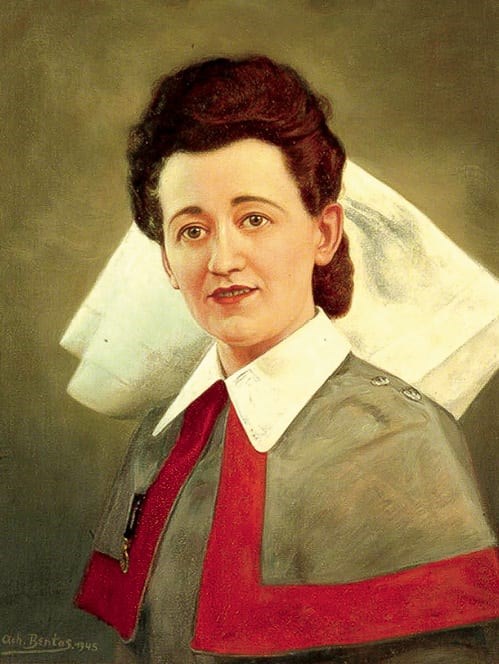When World War I began, my grandparents could not have imagined that five of their ten children would sign up to fight overseas. At that time most of them lived in the village of Homer, near St. Catharines. The three boys, Alfred, Russell and my dad, Julius, joined first and trained in Niagara-on-the-Lake. At that time training with horses was necessary as much of the fighting in the field was on horseback. During the early training my dad was injured in his knee from the flying hooves of an out-of-control horse, so was given an honorable discharge. He was 39 and felt badly at this turn of events, as he considered it a great honour to fight for your country.
Russell was the first to join, in December 1914, enlisting as a private in the Canadian Army Service Corps, and five months later was promoted to Captain of the Canadian Expeditionary
Force when they were shipped overseas. He proceeded to France two months later. Within a week he faced five horrible days in “No Man’s Land,” where he was badly wounded and captured by the Germans. Because his army tag was found and brought back to base, Russ was declared dead and the family in Canada received this news with grieving hearts. In actual fact, Russ was taken prisoner by the Germans in Wurzburg and spent 22 months of horror in a prisoner of war camp. Most of his father’s letters never got to him, although his monthly letters to his family in Canada arrived safely. In May 1918, Russ was released and sent to Holland for six months’ rehabilitation before coming home to Canada. Looking at a photograph of Russ after he returned home is to look into the face of a haunted man.
Alfred enlisted in Haileybury, Northern Ontario. His jewelry story had burned previously so there was little keeping him. In 1915 he was promoted to Captain after being Lieutenant in the 97th Regiment. In June 1916 he left for France as Major Alfred James Ansley. Alf was killed in action near Corcelette, in the Abert-Bapaume Sector, in October 1916. As one of the soldiers whose graves are not known, his name is commemorated on the Vimy Memorial, France, reading:
ANSLEY – Major Alfred James, 15th Battalion, (1st Central Ontario Reg’t.) 14th October, 1916.
The other two Ansleys who created quite a stir in the family were two of the six sisters who trained as nurses —Nora and Gladys. It was at Nora’s suggestion that a nursing career would suit her and persuaded Gladys to join her. They applied at several hospitals in the US and Canada but it was only the prestigious Bellevue Hospital in New York City that would take sisters. Their father was furious at this decision to be nurses, believing that it was no profession for ladies. Apparently, the famous work of Florence Nightingale had not yet made its impression.
The training was rigorous, demanding, but exhilarating, and they graduated in 1916. Almost the last straw for their father to bear was that they wanted to nurse overseas. However, Nora and Gladys put their names on the waiting list only to learn that there was a backlog of thousands. But a friend in England sent them an advertisement from a British newspaper asking for nurses to join the “Queen Alexandra’s Imperial Military Nursing Service Reserve.” (Queen Alexandra was the wife of King Edward VII). They applied at once, were accepted immediately, enlisting at Toronto on February 9, 1917. In England their uniforms were made for them—grey, with a grey cape edged in scarlet. Their headdress was a square of soft white cloth, to be carefully fastened at the nape of the neck. The Matron, as Superintendent of Nurses, was a veteran of the Boer War and knew nearly all the military personal of the African war days. She wore the grey nurses’ uniform but with the full scarlet red cape.

Most of Nora’s and Gladys’ military nursing was in the Italian city of Taranto, on the inside of the heel of the “Italy boot.” They lived in unheated tents that were fine in summer but the winters were cold and rainy. Water collected on the floor, their beds were damp, and shoes and clothing had to be hung on the walls somehow. But they enjoyed the challenge of the work, knowing that they were helping life. Letters received and filed after the war from their former patients thank them for their thoughtfulness, care, and for treating their charges as human beings. The hospital was the target of bombs occasionally, but they were unharmed.
The sisters —always the planners —often would talk about what they would l like to do after the war, together, if possible. Dared they think of having a business where the six sisters could handle being together? Perhaps it could be a school of some kind, or a convalescent hospital. These plans were percolating in Nora’ s and Gladys’ heads while they were nursing the soldiers.
But Nora was developing severe pain that turned into a very painful type of rheumatoid arthritis. Eventually she had to be invalided home near the end of the war in a crippled condition. All their plans were on hold. After the war the family were together again and their next chapter began in 1920— organizing the first school of its kind in Canada, with Nora as Matron —but that is another tale. ◆
Everyone has a story. Tell yours in Column Six. [email protected]


